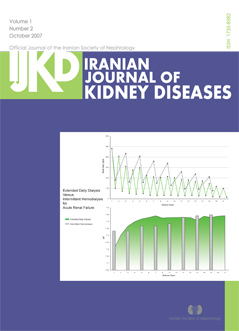Proteinuria After Kidney Transplantation: Its Relation to Hepatitis C Virus and Graft Outcome
Abstract
Introduction. Chronic Hepatitis C Virus (HCV) infection has been associated with glomerular disease in native and transplanted kidneys. We evaluated the presence of HCV infection at the time of transplantation and occurrence of proteinuria in Egyptian kidney transplant patients and their link with graft survival.
Materials and Methods. This retrospective study was done on 273 patients with end-stage renal disease transplanted in Mansoura Urology and Nephrology Center Between 1993 and 1996. Their sera were routinely assayed for anti-HCV antibodies at the time of transplantation. The relationship between the HCV and the development of posttransplantation proteinuria was evaluated, along with the possible effects of proteinuria on long-term graft survival.
Results. A total of 169 kidney recipients (61.9%) were positive for anti-HCV antibodies. The mean durations of post-transplant follow-ups were 87.73 ± 26.79 months (range, 19 to 123 months) and 84.29 ± 28.55 months (range, 11 to 123 months) for the patients with and without anti-HCV antibodies, respectively. The patients in these groups were comparable regarding the incidence of proteinuria (33% and 32%, respectively) and its quantity (median, 0.6 g/d and 0.4 g/d, respectively). Irrespective of the HCV infection, patients with nephrotic-range proteinuria showed a worse graft survival (P < .001) and a higher frequency of chronic allograft nephropathy (P = .03) compared with nonproteinuric patients.
Conclusions. There is a high prevalence of HCV infection in our patients with end-stage renal disease awaiting kidney transplantation. The incidence and quantity of proteinuria do not increase by HCV infection, and nephrotic-range proteinuria is independently associated with chronic allograft nephropathy and a poorer graft outcome.





